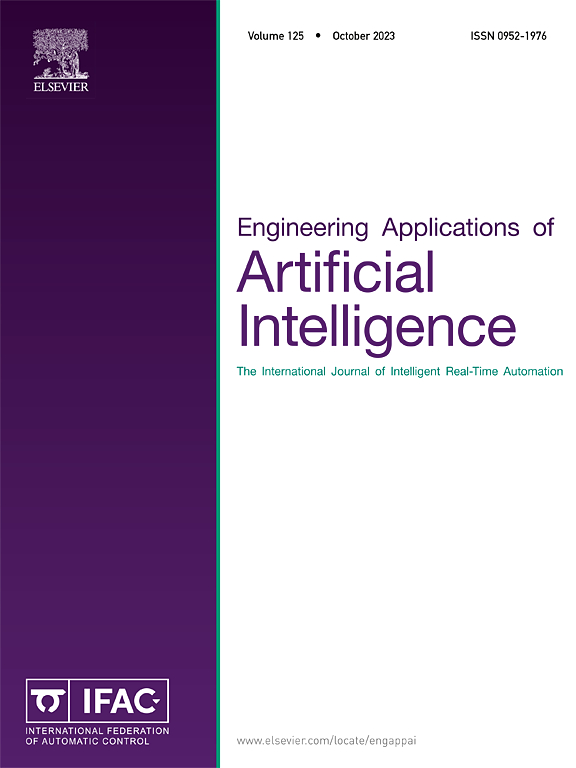SCB-ADAE: An attention-based deep autoencoder for ground penetrating radar signal denoising
IF 8
2区 计算机科学
Q1 AUTOMATION & CONTROL SYSTEMS
Engineering Applications of Artificial Intelligence
Pub Date : 2025-07-31
DOI:10.1016/j.engappai.2025.111902
引用次数: 0
Abstract
In buried object detection, recorded signals of a ground penetrating radar (GPR) inevitably include noise interference owing to complex underground environments. Existing rule- and data-driven denoising methods struggle to handle non-Gaussian and real-world noise because the rule-driven ones rely on the assumptions of simplified noise characteristics and the data-driven ones cannot capture fine- and global-scale features of a GPR signal well. To address the problem, this study proposes an attention-based denoising model called the Swin-Conv Block with Attention Denoising Autoencoder (SCB-ADAE). The model first feeds a GPR signal into a SCB module, which extracts a tensor with the fine-scale features in the signal, such as sharp reflective interfaces and abrupt amplitude variations. The feature tensor then passes through an ADAE module that uses encoder-decoder structure with the self-attention to enhances the representation of the global-scale signal features. Finally, the feature tensor from the ADAE module is decoded by another SCB module to generate a denoised GPR signal, where the tensor includes the fine-scale and global features of the raw signal. An experiment with three types of GPR signals demonstrates the effectiveness of the proposed model: radar signals with Gaussian noise, radar signals with inhomogeneous-material noise, and real-world signals. radar signals with Gaussian noise, radar signals with inhomogeneous-material noise, and real-world signals. Experimental results demonstrate that the proposed model outperforms other state-of-the-art denoising methods on denosing the three types of GPR signals, where the signal-to-noise ratio, peak signal-to-noise ratio, and structural similarity index are improved to 20.64, 14.59, and 0.366, respectively.
SCB-ADAE:用于探地雷达信号去噪的基于注意的深度自编码器
在地埋物探测中,由于复杂的地下环境,探地雷达(GPR)记录的信号不可避免地存在噪声干扰。现有的规则驱动和数据驱动去噪方法难以处理非高斯噪声和真实世界的噪声,因为规则驱动的方法依赖于简化噪声特征的假设,而数据驱动的方法不能很好地捕获GPR信号的精细和全局尺度特征。为了解决这一问题,本研究提出了一种基于注意的去噪模型,称为带有注意去噪自动编码器(SCB-ADAE)的swan - conv块。该模型首先将探地雷达信号输入到SCB模块中,SCB模块提取一个具有信号中尖锐反射界面和振幅突变等精细尺度特征的张量。然后,特征张量通过ADAE模块,该模块使用具有自关注的编码器-解码器结构来增强全局尺度信号特征的表示。最后,来自ADAE模块的特征张量由另一个SCB模块解码,生成去噪的GPR信号,其中该张量包含原始信号的精细尺度和全局特征。通过对三种探地雷达信号(高斯噪声雷达信号、非均匀材料噪声雷达信号和真实信号)的实验验证了该模型的有效性。具有高斯噪声的雷达信号,具有非均匀材料噪声的雷达信号,以及真实信号。实验结果表明,该模型对三类探地雷达信号的去噪效果优于现有的去噪方法,信噪比、峰值信噪比和结构相似指数分别提高到20.64、14.59和0.366。
本文章由计算机程序翻译,如有差异,请以英文原文为准。
求助全文
约1分钟内获得全文
求助全文
来源期刊

Engineering Applications of Artificial Intelligence
工程技术-工程:电子与电气
CiteScore
9.60
自引率
10.00%
发文量
505
审稿时长
68 days
期刊介绍:
Artificial Intelligence (AI) is pivotal in driving the fourth industrial revolution, witnessing remarkable advancements across various machine learning methodologies. AI techniques have become indispensable tools for practicing engineers, enabling them to tackle previously insurmountable challenges. Engineering Applications of Artificial Intelligence serves as a global platform for the swift dissemination of research elucidating the practical application of AI methods across all engineering disciplines. Submitted papers are expected to present novel aspects of AI utilized in real-world engineering applications, validated using publicly available datasets to ensure the replicability of research outcomes. Join us in exploring the transformative potential of AI in engineering.
 求助内容:
求助内容: 应助结果提醒方式:
应助结果提醒方式:


